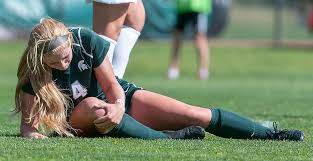Personal Trainer in CT, Cameron F., talks about a common injury.
An ACL injury is the tearing of the anterior cruciate ligament (ACL) — one of the major ligaments in your knee. ACL injuries most commonly occur during sports that involve sudden stops, jumping or changes in direction — such as basketball, soccer, football, tennis, downhill skiing, volleyball and gymnastics. Many people hear or feel a “pop” in the knee when an ACL injury occurs. Your knee may swell, feel unstable and become too painful to bear weight. Depending on the severity of your ACL injury, treatment may include rest and rehabilitation exercises to help you regain strength and stability or surgery to replace the torn ligament followed by rehabilitation. A proper training program may help reduce the risk of an ACL injury.
Risk Factors:
Women are more likely to have an ACL injury than are men who participate in the same sports. Studies have suggested some reasons for these differences in risk. In general, women athletes exhibit a strength imbalance in their thighs with the muscles at the front of the thigh (quadriceps) being stronger than the muscles at the back (hamstrings). The hamstrings help prevent the shinbone from moving too far forward — movement that can overextend the ACL. Studies comparing jumping and landing techniques among men and women athletes have shown that women athletes are more likely to land from a jump in a way that increases stress on their knees. Research suggests that training to strengthen muscles of the legs, hips and lower torso — as well as training to improve jumping and landing techniques — may reduce the higher ACL injury risk associated with women athletes.
Signs and symptoms of an ACL injury usually include:
- A loud “pop” or a “popping” sensation in the knee
- Severe pain and inability to continue activity
- Swelling that begins within a few hours
- Loss of range of motion
- A feeling of instability or “giving way” with weight bearing
Causes:
Ligaments are strong bands of tissue that connect one bone to another. The ACL, one of two ligaments that cross in the middle of the knee, connects your thighbone (femur) to your shinbone (tibia) and helps stabilize your knee joint.
Most ACL injuries happen during sports and fitness activities that can put stress on the knee:
- Suddenly slowing down and changing direction (cutting)
- Pivoting with your foot firmly planted
- Landing from a jump incorrectly
- Stopping suddenly
- Receiving a direct blow to the knee or collision, such as a football tackle
When the ligament is damaged, there is usually a partial or complete tear across the tissue. A mild injury may overextend the ligament but leave it intact.
Prevention:
Proper training and exercise can help reduce the risk of ACL injury. A physical therapist, athletic personal trainer in Connecticut or other specialist in sports medicine can provide assessment, instruction and feedback that can help you reduce risks. Programs to reduce ACL injury include:
- Exercises that strengthen leg muscles, particularly hamstring exercises, to ensure an overall balance in leg muscle strength
- Exercises to strengthen the core: hips, pelvis and lower abdomen
- Training and exercise for proper techniques and knee position in jumping and landing
- Training to improve techniques for pivoting and cutting
In the end, make sure that your workouts are beginning/ending with a warmup/cooldown. That in itself is critical for the reason that properly preparing the body for exercise reduces injuries. Our Personal Trainers in CT are always dealing with these issues and if you need any recommendations click here!
Cameron is a leading success coach and personal trainer at Horizon Personal Training in CT. Cameron is a NASM Certified Personal Trainer and keeps up to date on the latest fitness trends to ensure success within one’s self! To learn more about Cameron please go to www.horizonpersonaltraining.com.






